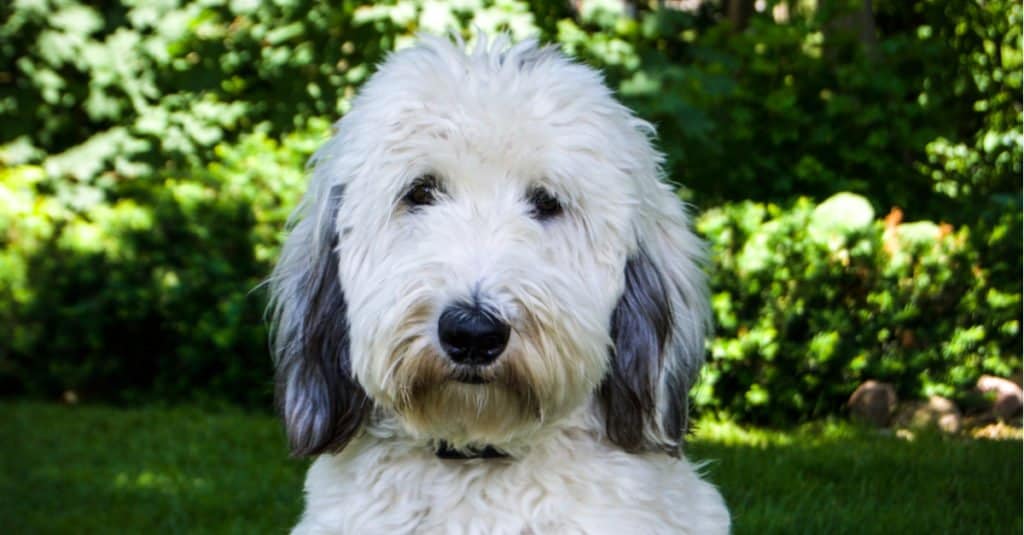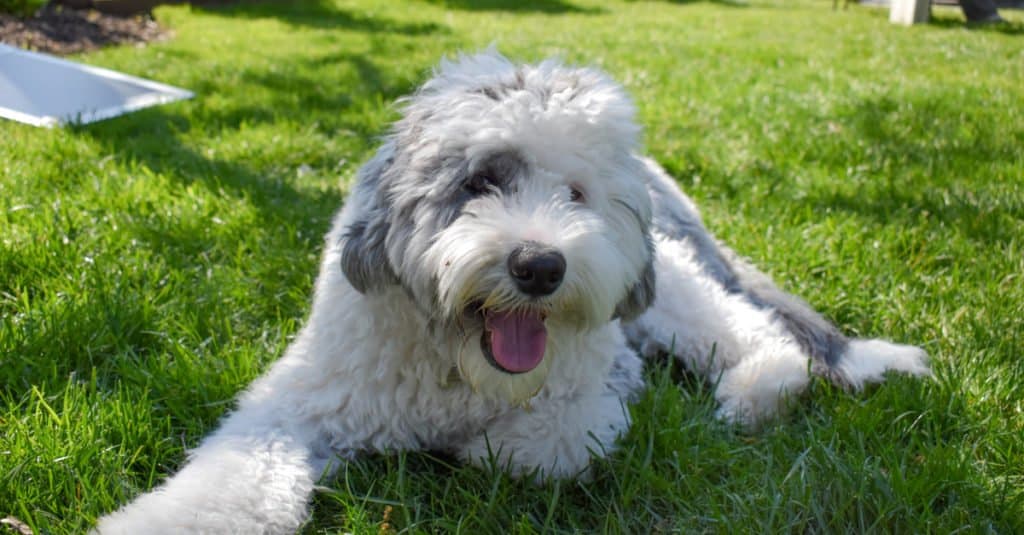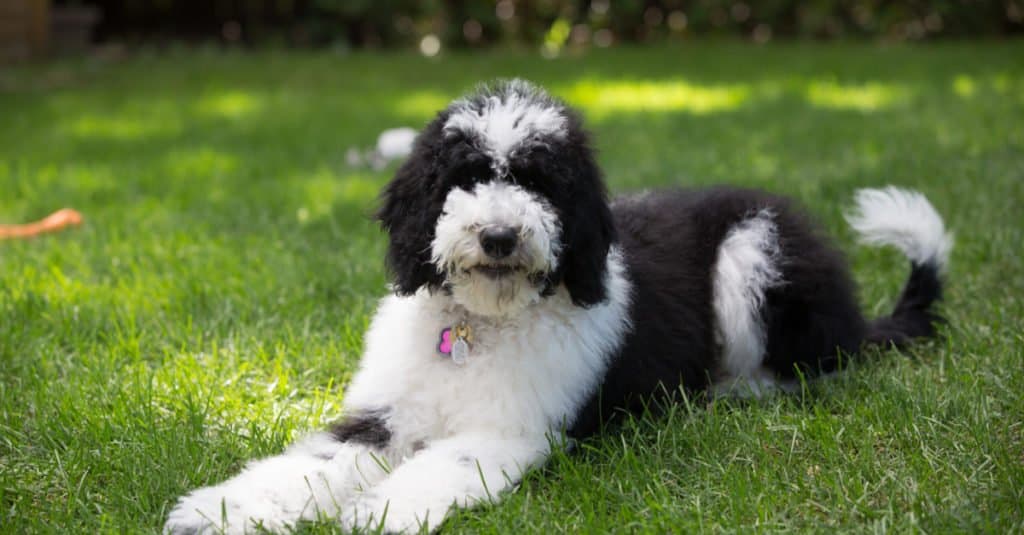Sheepadoodle
Sheepadoodles were first bred as an experiment for use as a military dog in the Army in the 1960s, however they didn’t really gain popularity until 2007.
Advertisement
Sheepadoodle Scientific Classification
- Kingdom
- Animalia

Sheepadoodle Facts
Sheepadoodle Physical Characteristics
Sheepadoodle as a Pet:
- General Health
- Energy Level
- Shedability
- Trainability
- Intelligence
- Tendency to Chew
- Size
- Family and kid friendliness
- Yappiness / Barking
- Silent
- Hypoallergenic
- Yes
- Separation Anxiety
- High
- Preferred Temperature
- Average climate
- Exercise Needs
- High
- Friendly With Other Dogs
- High
- Pure bred cost to own
- $1,500 to $3,000
- Dog group
- Toy
- Male weight
- 60-80 lbs
- Female weight
- 45-60 lbs
This post may contain affiliate links to our partners like Chewy, Amazon, and others. Purchasing through these helps us further the A-Z Animals mission to educate about the world's species.
View all of the Sheepadoodle images!
The Sheepadoodle was designed to be a good pet for allergy sufferers since the Poodle is hypoallergenic.
The Old English Sheepdog and the Poodle were mixed together to create the Sheepadoodle. Also known as Sheep-a-poo, Sheepdoodle, Sheepdogpoo, and Sheeppoo, this breed was designed to be a good pet for allergy sufferers, since the Poodle is hypoallergenic. Sheepadoodle breeders may breed an Old English Sheepdog with either a standard, miniature, or toy poodle, so the size of a Sheepadoodle can vary quite a bit. A standard Poodle is most commonly used, though, so most Sheepadoodles weigh between 60 and 80 pounds.
See all of our expert product reviews.
Most Sheepadoodles are black, white, or black and white. Some may have rare gray-colored fur or a patch of color around their eyes. Sheepadoodles can make a wonderful addition to many families. They are very loving, playful, and even-tempered. Sheepadoodles don’t like being left alone, so this breed is ideal for homes where someone will be with the dog most of the day.

3 Pros And Cons Of Owning A Sheepadoodle
| Pros! | Cons! |
| Even-tempered: Sheepadoodles are very even-tempered and can make a good family dog. | May be destructive if left alone: Sheepadoodles like being around the people in their family and may be destructive if they are home alone for too long. |
| Hypoallergenic: Sheepdoodles shed very little or none at all, making them a great choice for allergy sufferers. | Can be expensive: Depending on the type of Sheeppoo puppy you want to purchase, you may spend quite a bit. Micro Sheepadoodle puppies, for example, can cost $2,200 or more. |
| Intelligent: Sheepadoodles are smart and generally easy to train. | May nip: Puppies may nip since it is in the herding genes they inherited from the Old English Sheepdog parent. You will want to start training early to stop this behavior. |

Sheepadoodles enjoy spending time cuddling with their family on the couch.
©Jason Grant/Shutterstock.com
History Of The Breed
Unlike most mixed breeds that were created as part of the designer dog craze, the sheepadoodle was actually a creation of the U.S. Army. It originated in the 1960s as an experimental military dog and was intended to be a guard dog due to its loyalty, intelligence, bravery and intuitive nature. Because they were extremely playful and carefree, they were retired fairly quickly and became popular pets, for that same reason. They began to regain popularity again around 2007.
Types Of
The type of sheepadoodle you get depends on which type of parent breed Poodle is mixed with the parent Old English Sheepdog. Here are just a few types of sheepadoodles you can have:
Health and Entertainment for your Sheepadoodle
See all of our expert product reviews.
- Mini or medium – a miniature poodle and an Old English sheepdog
- Toy – toy poodle and a mini sheepadoodle
- Standard – a standard poodle and an Old English sheepdog
Size And Weight
Sheepadoodles are a large breed of dog. Males are generally between 13 and 24 inches tall and weigh between 60 and 80 pounds. Females are typically between 13 and 24 inches tall and weigh between 45 and 65 pounds. These numbers are large ranges because the exact size of each Sheepadoodle can vary quite a bit depending on the mix of genes they inherit from their Old English Sheepdog and Poodle parents. Micro Mini Sheepadoodles, with a Toy Poodle parent, can be even smaller. These dogs can weigh less than 20 pounds.
| Height (Male): | 13 inches to 24 inches |
| Height (Female): | 13 inches to 24 inches |
| Weight (Male): | 60 pounds to 80 pounds |
| Weight (Female): | 45 pounds to 65 pounds |
Common Health Issues

Sheepadoodles may develop some of the issues that their parent breeds are prone to, like cataracts and hip dysplasia.
©Logan Swenson/Shutterstock.com
Before bringing home a Sheepadoodle, take a few minutes to learn about some of the potential health problems this breed may face. Every Sheepdogpoo will not develop all, or even any, of these problems, but knowing what to look for can help you decide if you need to seek medical attention for your pup.
Hip dysplasia is one potential problem to look out for. Hip dysplasia occurs when the hip bone doesn’t form properly and the thigh bone and hip bone rub together. This problem is more prevalent in large breed dogs, like the Sheepadoodle, and may require surgery.
Since cataracts are a big problem for Poodles, a Sheepadoodle may also develop them. Cataracts can impact a dog’s vision and may cause them to start bumping into things as they walk. Your veterinarian should be able to treat cataracts with surgery.
A third potential concern is Addison’s disease. Dogs with this disease don’t produce enough cortisol, which can cause lead to panting, an increased heart rate, or too much drinking or urinating. If your dog develops these symptoms, bring them to the vet who may be able to prescribe replacement hormones to remedy the situation.
To sum up, a few potential health concerns Sheepadoodles may suffer from include:
- Hip dysplasia
- Cataracts
- Addison’s disease
Temperament And Behavior

Sheepadoodles were bred to be companion dogs. They love spending time with the people in their family but don’t tolerate being left alone too well.
©Lisa Mounteer/Shutterstock.com
Sheepadoodles have a great personality. This breed is very affectionate and intelligent. They can be very playful and active at times but also enjoy spending time cuddling with their family on the couch. A Sheepdoodle’s personality traits make them an excellent dog for families with children. However, since half of their genes come from the Old English Sheepdog who is a herding dog, they may nip at the heels of toddlers and young children and try to ‘herd’ them. You can generally train them not to do this relatively easily, however, but you may want to wait to get a Sheepadoodle until your children are a little older.
Sheepadoodles were bred to be companion dogs. They love spending time with the people in their family, but don’t tolerate being left alone too well. If a Sheepdogpoo is left alone for too long, they can develop separation anxiety. This can lead to destructive or other undesirable behaviors, such as barking.
How To Take Care Of A Sheepadoodle
When preparing to care for a Sheepadoodle, keep the breed’s temperament, potential health concerns, nutritional needs, activity needs, and other characteristics in mind. This will allow you to offer your Sheepadoodle the best care possible and keep them happy and healthy.
The Best Dog Food For Sheepadoodles
Look for a high-quality dog food formulated for a large-breed dog for a Sheepadoodle. The ideal amount of food can vary based on a Sheepadoodle’s size, activity level, age, metabolism, health concerns, and more. Most adult Sheeppoos generally eat between 3 and 4 cups of food each day. Split the total recommended amount of food for your dog into two or three servings to prevent your pup from over-eating. Leaving food out all day for free feeding is not recommended for this breed.
Sheepadoodle puppies should be fed high-quality puppy kibble. They are prone to obesity and puppies have a smaller stomach, so you will need to feed your dog smaller, more frequent meals each day. This will allow them to fully digest their food and won’t stretch out their stomach. Puppies under six months old should be fed four meals each day. Once your Sheepadoodle is six months old, you can switch to two or three meals a day.
At A-Z Animals, we’d say the best dog food for Shepadoodles is Wellness CORE Dry Dog Food with Wholesome Grains, High Protein Dog Food.
Made from satisfying chicken and turkey, the real meat in this kibble is a natural source of glucosamine and chondroitin, so your Sheepadoodle will have mobile joints. Also, since this food contains taurine, your dog will benefit from eye and vision support.
Try feeding your dog Wellness CORE High Protein dog food, available on Chewy or Amazon.
- Turkey and chicken meal and deboned chicken with wholesome grains
- 34% protein promotes lean body mass and muscle tone
- Omega fatty acids support healthy skin and coat
- Glucosamine for strong joints, probiotics for digestive health and taurine for a healthy heart
- No poultry by-products, wheat, wheat gluten, corn, soy, artificial colors, or preservatives
Maintenance And Grooming

Sheepadoodles can have a variety of coat colors and types, depending on the genes they inherit from their parent breeds.
©Sydney Jones/Shutterstock.com
A Sheepadoodle’s coat type and color can vary based on the genes it inherits from its Poodle and Old English Sheepdog parents. Most have a long coat that might be curly, wavy, or flat. Most of this variety shed minimally or don’t shed at all. However, just because they don’t shed doesn’t mean you don’t need to brush a Sheep-a-poo. You should brush your dog’s coat between two and three times each week. This will prevent it from getting matted, remove dirt and debris, and keep it looking its best. Sheepadoodles often require professional grooming for their longer and curlier coats. Most will need to have their coats trimmed by a groomer or their owner at least every two to three months.
Your Sheepadoodle will also need to have his nails trimmed regularly to keep them from getting too long. When the nails are too long, it can become painful for your dog to walk. You should also check your Sheepadoodles ears regularly and remove any dirt or debris. Use an ear-cleaning solution for dogs to keep their ears clean and prevent too much wax from building up. This can lessen the chances that your dog will develop an ear infection. Finally, don’t forget to brush your Sheepadoodle’s teeth. This should be done a few times each week. Without proper brushing, plaque and tartar can build up and eventually may lead to dental disease and further health problems.
Training
In general, training a Sheepadoodle should be pretty simple. This breed is highly intelligent and obedient. They also aim to please their owners, so they should be able to learn and respond to commands relatively quickly. It is important, however, to begin the training process from an early age. This will help your pet learn commands from an earlier age. They’ll also be smaller when they’re still a puppy and easier to control.
In addition to training your Sheepadoodle, socializing them from an early age is also important. Introduce your Sheepadoodle to other dogs and people. Bring them with you to a variety of places. This will help your dog learn how to interact with different people and animals as well as how to act in different situations. You may want to wait until your dog is fully vaccinated to introduce them to other dogs or bring them to too many places with you, though.
Exercise
Sheepadoodles are a high-energy breed. Your pet will require daily exercise to get out their energy and maintain a healthy weight. Adult Sheepadoodles will need at least 60 minutes of exercise each day. Too much exercise isn’t good for a puppy’s development, so try to stay within five minutes of exercise for each month of age. This means three-month-old puppies should only get about 15 minutes of exercise.
Puppies

Sheepadoodle puppies are great with children and are easy to train.
©Lisa Mounteer/Shutterstock.com
While Sheepadoodles are relatively easy to train, it is recommended to start training your puppy as soon as you bring him or her home. Training your dog while he or she is still a puppy will help them learn the necessary behaviors and expectations before they get too big to control. In addition to early training, you should also begin socializing your dog and introducing him or her to different people, pets, and situations from a young age.
Before you bring your new Sheep-a-poo puppy home for the first time, make sure your home is ready. Purchase the food, crate, bed, and other supplies your pup will need. You will also want to make sure that your home is puppy-proofed and remove anything that you don’t want damaged by the puppy as well as any potentially dangerous items.
Sheepadoodles And Children
If you’re looking for a breed that will make a great companion for a child, Sheepadoodles are an excellent choice to consider. They are very loving, affectionate, and tolerant with children. Sheepadoodles can also make a great playmate for a child. They enjoy playing around and can be quite silly. Some Sheepadoodles may inherit the herding instinct from the Old English Sheepdog parent, which may make them try to herd smaller children or nip at their heels. If you have a baby or a toddler, you may want to wait until your child is a bit older to try to avoid this potential issue.
Dogs Similar To Sheepadoodle
Old English Sheepdogs, Poodles, and Bearded Collies are three breeds that are similar to the Sheepadoodle.
- Old English Sheepdog: The Old English Sheepdog makes up half of the Sheepadoodle’s genes. Both breeds are very friendly and good with kids. Old English Sheepdogs are heavier shedders and more likely to bark than Sheepadoodles.
- Poodle: The Poodle makes up the other half of a Sheepadoodle’s genes. Both breeds are intelligent and easy to train. Some Sheepadoodles are larger than Poodles. Sheepadoodles can weigh 80 pounds or more compared to the standard 65-pound max for a Poodle.
- Bearded Collie: Bearded Collies and Sheepadoodles are both very loving and intelligent dogs that make a great family dog. Bearded Collies are smaller than Sheepadoodles. They generally weigh between 45 and 55 pounds compared to the typical 60 to 80 pounds a Sheepadoodle may weigh.
Famous Sheepadoodles
Sheepadoodles are a fantastic dog breed. There are even a few famous Sheepadoodles out there.
- Bilbo is the Sheepadoodle who was adopted by Meryl Davis, an Olympic gold medal winner.
- Otis is a Sheepadoodle with over 190,000 followers on Instagram. His owners post updates showcasing Otis’ personality and all the shenanigans he gets into.
- Zammy the Sheepdogpoo is another Instagram sensation. He is a 106-pound children’s hospital therapy dog who has also been featured on BuzzFeed, UNILAD, The Dodo, and 9gag.
Popular Names For Sheepadoodle
Want to pick the best possible name for your new Sheepadoodle? Read through the suggestions below and see if one feels like a good fit.
- Sammy
- Riley
- Oscar
- Pepper
- Smoky
- Emma
- Cassie
- Duchess
- Maggie
- Annie
Sheepadoodle FAQs (Frequently Asked Questions)
How much does a Sheepadoodle cost to own?
The cost of purchasing a Sheepadoodle from one of the breeders near you can vary. Some Sheepadoodles may cost as little as $1,500 while others may be over $3,000. The type of puppy can make a difference in the price too. For example, standard Sheepdoodle puppies cost about $1,500, Mini Sheepadoodle puppies cost about $1,900, and Micro Sheepadoodle puppy costs around $2,200. You may also be able to find a Sheepadoodle to adopt through a rescue organization or shelter. Adopting through a rescue organization should only cost $300 or less to cover adoption fees and vaccinations.
Your Sheepadoodle will also require veterinary care, food, a dog bed, a crate, a leash and collar, toys, treats, and various other supplies. Since you will have to gather all of the supplies your dog will need during your first year of ownership, expect that year to be the most expensive. You should budget between $1,000 and $1,500 for the first year you own your Sheepadoodle and between $500 and $1,000 for each of the following years.
Is a Sheepadoodle good with kids?
Yes, Sheepadoodles are very good with kids. This breed is playful, loving, and silly, making them an ideal companion for a child. However, since half of the Sheepadoodles genes come from the Old English Sheepdog, which is a herding dog, they may playfully try to ‘herd’ a child or nip at their heels. For this reason, Sheepadoodles may be best suited for a home with older children.
How long does a Sheepadoodle live?
Most Sheepadoodles live between 10 and 15 years.
What is a Sheepadoodle?
A Sheepadoodle is a hybrid, or mixed, dog breed that is half Old English Sheepdog and half Poodle. Standard, toy, and mini-sized Poodles may be used to breed a Sheepadoodle which accounts for the wide range of sizes for this breed. Most Sheepadoodles weigh between 60 and 80 pounds, but the Micro Mini Sheepadoodle (with a Toy Poodle parent) can weigh less than 20 pounds.
Sheeppoos are very gentle, friendly, and affectionate. They can make a great family dog. This breed does well with children and is also known for their silly behaviors, which makes them an even better companion for a child. Sheepadoodles are generally easy to train, especially when training and socialization are started from an early age. The breed is very intelligent and strives to please its owners.
How do you groom a Sheepadoodle?
Sheepadoodles rarely shed, but their long coats will still need to be brushed a few times every week to keep it looking shiny and remove any dirt or debris that may be trapped in their hairs. The coat of a Sheep-a-poo may be wavy, curly, or straight. Most have a longer coat that requires trimming every two to three months to keep it from getting too long or matted. If you aren’t comfortable trimming your Sheepadoodle’s coat yourself, you may want to look for a professional groomer.
In addition to brushing your dog’s coat and keeping it trimmed, you will also need to brush their teeth, trim their nails, and clean their ears on a regular basis.
Are Sheepadoodles hypoallergenic?
Yes, with their half-Poodle DNA, Sheepadoodles are hypoallergenic. They shed minimally or don’t shed at all.
Do Sheepadoodles bark a lot?
Sheepadoodles rarely bark. If your dog doesn’t get enough stimulation or is left home alone for too long, they may possibly bark.
What's the difference between Sheepadoodles and Bernedoodles?
The main difference between Sheepadoodles and Bernedoodles is their genetics, as well as when they were bred. The Sheepadoodle was bred from an English Sheepdog and a Poodle in the 1960s, while the Bernedoodle was bred in the early 2000s with a Poodle and a Bernese Mountain Dog.
What are the differences between an Old English Sheepdogs and a Sheepadoodle?
The most significant differences between an Old English Sheepdog and a Sheepadoodle include breed, fur, and size.
Other differences include temperament, appearance, and lifespan.
Thank you for reading! Have some feedback for us? Contact the AZ Animals editorial team.
Sources
- dogtime.com / Published February 11, 2021
- k9web.com / Published February 11, 2021
- allthingsdogs.com / Published February 11, 2021
- dogmal.com / Published February 11, 2021
- chrissymarieblog.com / Published February 11, 2021
- tenoaksdoodles.com / Published February 11, 2021
- celebpulse.com / Published February 11, 2021
- hellobark.com / Published February 11, 2021
- My Sheeadoodle / Accessed May 5, 2023


















